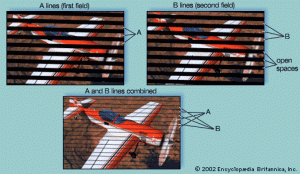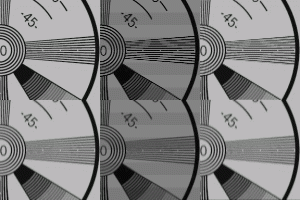Interlaced or progressive scanning
– don’t go wrong with them

Have you ever felt confused about all the gobbledygook around you? You know, the jargon that everybody uses but only a few really understand. And, to remain unseen, we sometimes pretend to understand what that bloody salesperson is talking about:
“This is the latest CCTV model with progressive scanning and full HD quality. Wide-angle perspective, hyper sensitive sensor with improved low light performance. You can’t go wrong with it.”
Really? I doubt. You CAN go wrong with it and today I want to cut through all the hype around picture scanning. Please, join me.
What is picture scanning?
CCTV cameras and other image creating devices use certain methods to record footages. Picture creation is determined and regulated by the sensor and the built-in microchip. The same applies to displaying devices.
As in the case of different recording standards, picture scanning methods come and go, leaving us in transitional periods when older standards are still present but newer ones haven’t yet taken place over them.
This is going on right now with picture scanning. And, have no doubt: it will go on for ever.
Interlaced method vs Progressive scan
Interlaced video was originally introduced by traditional analogue television systems. During the image creation this method creates only the odd lines within the picture and then the even lines of each frame. You can refer back to our megapixel article to understand lines better.
Interlaced method was an improvement in recording fast moving objects as instead of 25 full pictures, 50 half pictures were created. See figures below:

The interlaced picture creating method was (and is) used in the European PAL system too. Later, when digital cameras were introduced, they mimicked this approach; besides, displaying devices (e.g. monitors) were manufactured to match the recording standards. However, time has changed…
As HD was introduced, more and more image creating devices were built with the ability to create superb images applying progressive scanning. How does it differ from the interlaced method?
While in the interlaced scanning method every second line is scanned, in the progressive scanning method every line is scanned sequentially, from top to bottom. CRT monitors, LCD monitors and HDTV natively scan pictures in this manner.
Different countries use different standards
To make this whole situation even worse, different countries have created different standards.
Long story short, while we were using the interlaced PAL system with 25 FPS, the USA were using a different interlaced method called NTSC with 30 FPS.
Moreover, the American system had a different picture frame rate: 720×480 pixels which is why NTSC films can’t be played in PAL devices. Nonetheless, HD hasn’t solved the situation…
HD – interlaced and progressive
Interestingly enough, HD has several standards. Checking the description of different devices, you will read such definitions:
- 1080p: It refers to full HD, progressive scanning
- 1080p/50: It refers to full HD, progressive scanning and 50 FPS. It is great to create slow motion videos when you edit your footage. Not ideal for CCTV.
- 1080p/24: It refers to full HD, progressive scanning but instead of the standard 25 FPS, it records 24 frames per second which is popular in cinematography
- 1080i: It refers to full HD in interlaced picture scanning method. This standard is in use as there are still loads of displaying devices (TVs and projectors) that apply this scanning method.
- 720p: It refers to a HDReady standard: 1280×720 pixels. Progressive scanning method either with 25 FPS or 50 FPS
- etc.etc.
CCTV – DVR – Display: think in a system
You have to think in a system i.e. every device has to be able to process the data coming along the line. See what happens if the devices don’t apply the same standards:

On the left you can see a picture taken by a device applying the progressive scanning method. As your monitor displays pictures in the same manner, everything looks all right. However, in the middle and on the right, the images were taken with a device applying the interlaced scanning method. I think, the picture needs no more explanation.
Credit goes to Wikipedia.
So, to defeat the bloody salesperson in his own game and make a good decision that later satisfies you, you really have to get prepared.
Why not take one of our CCTV Installation Courses and cut through all the hassle? Get your own certificate.
